|
In the mid-1940s,
toward the end of World War II, Flying Aces magazine changed its name
to Flying Age, while changing its focus from model aviation to aviation
in general. Much to the consternation of many of its readers, that included no
longer including the much-loved fictional stories of flying superstars like
Kerry Keen (aka "the
Griffon"), Dick Knight
, Captain Philip Strange,
Battling Grogan
and his Dragon Squadron, Crash Carringer,
and of course Lieutenant Phineas Pinkham. The good aspect of the change is that
Flying Age published a lot of stories about full-size aircraft and flying which
were geared toward their audience of modelers who were interested in all aspects
of aeronautics. This piece discussed primarily variable pitch, constant speed
propellers being used on military, commercial, and civilian airplanes. You, like
I, though that by now there would be similar propellers available for model
aircraft use, but apart from a few homebuilts, no commercially made products are
available (there was one for indoor electrics, but nothing for powerful engines
/ motors). Given the number of variable-pitch rotor heads for helicopters, it
shouldn't be so hard to implement for airplane propellers.
Propellers
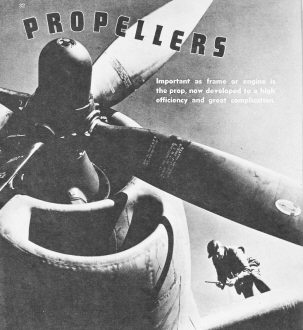
The great B-29 props, sixteen feet seven inches in diameter,
are the largest on any military airplane. Boeing Photo
Important as frame or engine is the prop, now developed to a high efficiency
and great complication.
The man who makes propellers is not always a happy man. When he hears or is told,
with business in mind, about a new airplane, his mind hurriedly skims his stock.
If he's one of the big prop boys, he may have seventy or more propeller designs;
if he's one of the smaller manufacturers, he may have only a few. But, somehow,
he has to fit the airplane to a propeller. Is it going to be single or dual rotation?
Shall it have three wide blades or four narrow blades? Will it be better with narrow
tips and wide shanks? How about using square tips?
Unless he's looking harshly at the jet-propulsion people, the propeller maker
is busily engrossed, therefore, in compromising with the engine maker and the airframe
maker. As long as airplanes are made in pieces and by long distance, that's going
to be true, The prop problem, consequently, is just as important to aviation as
the other two: what holds it up and what makes it go.
The propeller, of course, is the member of the plane-propulsion-prop combination
which has the job of delivering the maximum thrust horse-power possible from the
shaft of the engine. At the same time, it is an ungainly mechanism stuck out at
the end of the airplane. But it does give the aircraft forward thrust. So its positive
function far outweighs its negative values. It must, accordingly, be carefully designed,
absolutely functional and aerodynamically correct.
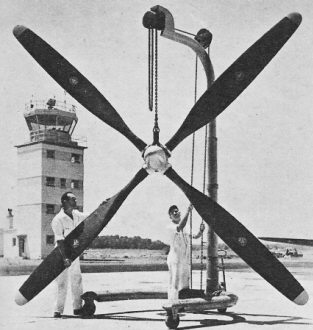
Fully-automatic, Curtiss electric propeller designed for bombers,
post-war transports. Curtiss-Wright Photo
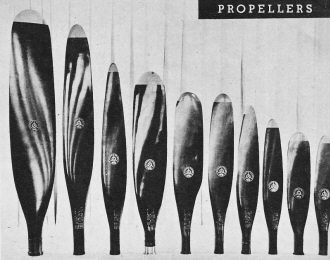
Ten varieties of Curtiss electric props. Of hollow steel, they
were pre-designed for warplanes, then modified. Curtiss-Wright photo
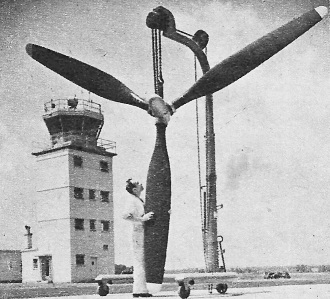
Most used is this three-blade prop. More than four blades are
not efficient, though five are used abroad. Curtiss-Wright photo
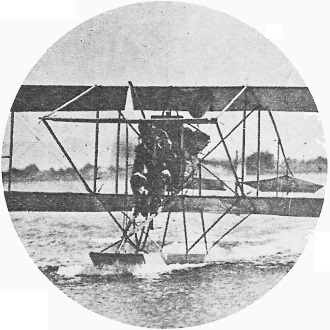
This Curtiss pusher, flying in 1912, used a fixed-pitch wooden
prop with slight anxiety about its efficiency. Official U. S. Navy photo.
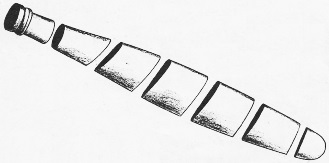
Diagram of a propeller shows its true airfoil construction. Note
how the airfoil changes as blade is constructed.
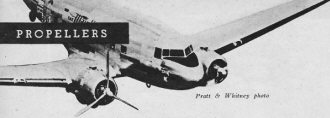
A DC-3 in flight with its left engine feathered. Full-feathering
props are required now on any multi-engine plane. When the engine is out during
flight, the prop acts only as drag. Pratt & Whitney Photo
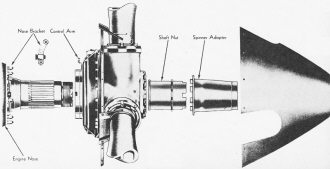
An exploded view of the installation of the Aeroprop (GM), hydraulically-operated
constant-speed prop used on U.S. fighters.
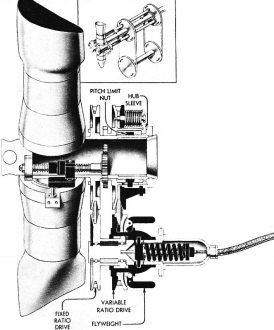
The Iso-Rev, by Zimmer-Thomson Corp., is a constant-speed prop
designed for small planes. It operates (left) by using split pulleys and two drives,
one fixed and the other variable with the pulleys. Pitch change is effected when
there's a difference between the ratio of the two drives.
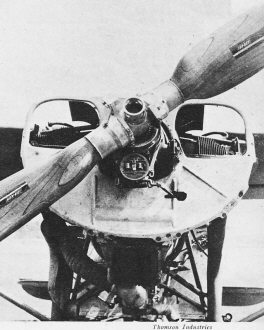
A V-belt is fastened to governor on nose.
When the Wright brothers were fussing around with heavier-than-air craft at the
beginning of the century, a propeller .problem was laughable, judged by the weightier
crisis of making the thing stay up in the air. But the Little World War, like its
far huskier offspring twenty years later, whizzed up aircraft research until, as
higher speeds, horsepowers and efficiencies were attained, designers began to worry
about the windmill laboriously pulling their aircraft through the air.
Fundamentally, the blade of the propeller is an airfoil with all its characteristics.
All you have to do is twirl the airfoil rapidly in a vertical position instead of
passing it through the air like a wing - and there's the blade airfoil. The pitch
of the propeller is, simply, the twist or angle of the blade to present the best
possible aerodynamic combination, or to get the best bite through the air. In the
old days, manufacturers almost always used laminated wood in a single piece bolted
to the engine nose. The same type, with modifications, of course, is still used
on small, private aircraft.
But as planes and their uses became larger and more varied, inventors and engineers
have labored - for the past. twenty-five years - to design a hoped-for perfect propeller
in which the pitch can be changed automatically by the natural forces to which any
propeller is subject when it's operating. In other words, the major goal has been
to make the propeller suit automatically changing conditions in the air.
Let's define the major types of propellers. The fixed pitch, as we've said, is
usually made in one piece from wood or dural and is quite light and simple. It's
designed for certain airplane and engine combinations to provide a set of selected,
compromised. flight conditions which can be obtained by the single, fixed angle
blades. Thus, if good take-off characteristics are the most important ones desired,
the propeller is designed to provide that one major feature, and cruise and top
speed are compromised in its favor.
Adjustable propellers are those which have a hub containing two or more blades
which may be adjusted when the plane is on the ground. The adjusting is done by
loosening the fastening of the blade and simply rotating them to a different angle.
This kind of propeller can be used in several different installations and provides
a way of getting a variety of performance characteristics. But in flight the adjustable
propeller acts exactly like a fixed-pitch prop and it can satisfactorily meet only
one condition at a time.
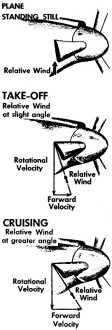
The diagrams (left) show how the pitch of a prop blade, affected under different
conditions by relative wind, is changed to get the best pitch conditions.
Controllable propellers cover a wide range of types. In general, any propeller
whose blades can be turned in flight at the pilot's direction is a controllable
type. Various features of controllables must be explained to qualify use of the
word when applied to a specific propeller.
The simple controllables are taken in hand by the pilot who manually changes
the angles of the blades through a linking or controls a mechanism which is powered,
handily enough, by the rotation of the propeller. But constant speed, feathering
and reversing propellers like those on large and very large aircraft (discussed
later) are controlled indirectly. The pilot sets a governing mechanism which takes
charge of the whole business by directing an auxiliary power source (electric or
oil pressure) to change the setting of the blade angle. The governor reflects changes
of engine speed and fixes the propeller around to get the very best performance
out of it without worrying the pilot.
The problem is, obviously, a simple one. It involves making the best, strongest
and lightest propeller. and then getting it to change its pitch, when necessary,
in the easiest way - preferably without bothering the pilot. But into it have gone
many years and many millions of dollars for research.
(Feathering, mentioned above, is now provided on practically all multi-engined
craft. It involves changing the pitch, or twisting the blades in the hub until they
lie in the direction of flight - or the width of the blade points in the same direction
as the airplane is going. In this position, the blade acts as a brake to stop the
engine's rotation, preventing further damage to the engine and preventing the vibration
that would result if the propeller continued to windmill. Drag is substantially
eliminated to the point where a multi-engine plane with one engine inoperative can
fly higher and faster with the propeller feathered. Large propellers capable of
being fully feathered have been in use in this country for more than five years.
And feathering will soon be available in several new types of props developed by
the AAF for powers under 500 hp.)
Of what materials are propellers made? Well - wood, of course. It's used on most
lightplanes. It's simple, light and inexpensive. Wood is not subject to failure
from fatigue, as are metals. No high-speed, high efficiency American aircraft uses
wood propellers. But the British during the war used a great deal of wood for their
fighter craft. They stubbornly maintain its efficiency. Most honest Englishmen will
now admit that their extensive use of wood propellers on combat planes was really
a war measure caused by the fact that they did not have enough forging capacity
to produce metal blades.
The best materials for blade construction are steel and duraluminum. Magnesium
props have been made, but, because they're less elastic than dural, they must be
thicker, which automatically makes them lose any weight advantage. The weight factor
is, naturally, tremendously important. That's why hollow blades are made. As sizes
increase, a point is finally reached at which the hollowed-out steel blade is equal
to the weight of a solid dural blade; with present blade designs, that's at about
thirteen inches. If it's to be wider, the blade section is so thick that it must
be hollow to have a reasonable weight.
That's not all the propeller maker has to worry him. His propeller has to suit
other considerations. What's the clearance of his propeller to be? And the clearance
factor is not only limited by the ground or water, but, in the case of a multi-engine
aircraft, by the closeness of one engine to another or to a structural part of the
plane. Is the installation to be tractor or pusher? If it's pusher, there's a big
problem raised with the turbulence caused by the air passing over the wing and flaps
into the propeller. That sets up an excitation or vibration. (The latter difficulty
may soon be overcome by proper design of the wing to reduce turbulence and closer
study of engine nacelle placement with regard to the areas of least turbulence on
the trailing edges.) What sort of job will the plane be asked to do? That's important
because it may even bear on the type of material to be used. During the war, for
example, many combat planes were operated from unimproved flying fields where the
propeller was subject to having stones and that sort of thing thrown up at it by
the landing or hose wheels. (Answer: hollow steel blades which are most resistant
to nicks.)
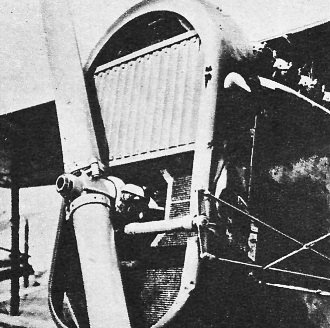
A controllable, reversible, hollow steel prop (1920) built by
Standard Steel and installed on engine of deH. biplane.
Then, when he has patted himself on the back for successfully completing an assignment,
the plane may be modified and upset all his calculations. That happened to Hamilton
Standard Propellers of United Aircraft, with its Mustang propellers. The P-51D was
nicely equipped with props having narrow tips and very wide shanks, all of which
provided better engine cooling, less compressibility effect and better performance
for that particular fighter. Then along came a new version, and the propeller had
to be changed into an item with square tips and a narrower shank.
He has to worry about the number of blades he's going to use. There has been
a trend (notably in the Rotols used on the Supermarine Spitfire) to use up to five
blades on a single propeller. Theoretically, the best propeller has an infinite
number of infinitely narrow blades. But the most important factor is the solidity
of the prop. The reason for the Spitfire's five blades is, simply, that with their
wooden blades and type of hub construction, they cannot use the wide blades used
in this country. To get the same degree of solidity, therefore, they have to add
blades. Thus, three wide blades with the same percentage of the total disk area
as five narrow blades result in just about the same performance, and they're a lot
cheaper and simpler. Many blades are really necessary only when the propeller operating
forces that result from the use of excessively wide blades are too great to be handled
practically.
Propellers used to be custom-built. With the tremendous quantities of planes
now in use and the .extreme variety of their uses, that's impossible now. The propeller
maker must try to anticipate every possible need of the aircraft and engine manufacturers
in advance. When they arrive with their specifications, he can select and refine
the most suitable prop he has in stock. And he knows how important it is, for, without
the right propeller, the airplane just isn't going to do its best job.
Posted May 1, 2023
|